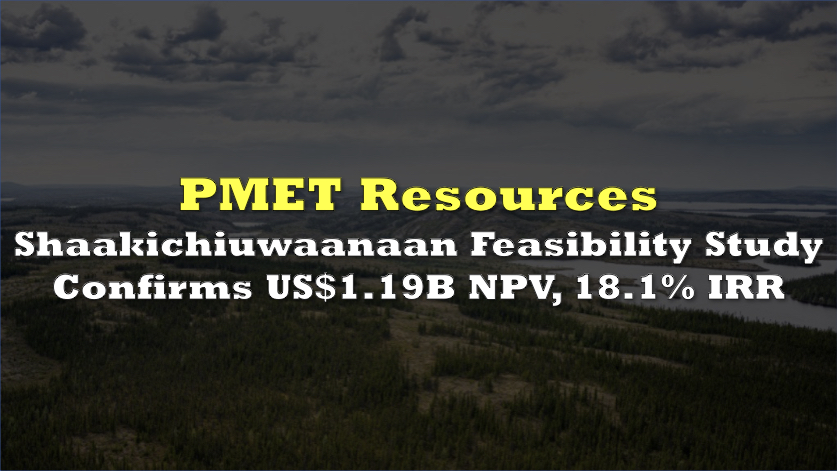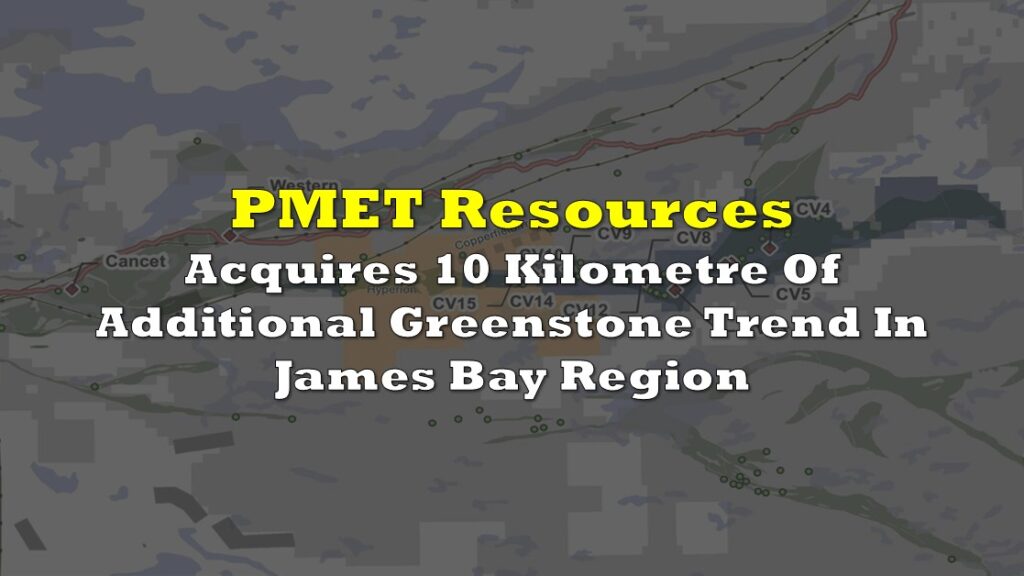PMET Resources (TSX: PMET) released a lithium-only feasibility study for the CV5 deposit at its Shaakichiuwaanaan Project that delivers an after-tax NPV8% of US$1.19 billion, an IRR of 18.1%, and a 4.7-year payback at a modeled spodumene price of US$1,221 per tonne.
The plan outlines a 19-year operation targeting a nominal 800,000 tonnes per year of SC5.5 at steady state and averaging 693,800 tonnes per year over the life of mine, for total life-of-mine production of 13.3 million tonnes of concentrate.
The reserve underpinning the study stands at 84.3 million tonnes grading 1.26% Li2O in the probable category, equivalent to 2.62 million tonnes of LCE, mined through a low-strip open pit and a higher-grade underground phase. The open pit operates across six sub-pits with an overall strip ratio of 3.4 to 1, followed by long-hole open stoping underground to lift nameplate output to roughly 800,000 tonnes per year.
Most figures are in CAD in the news release but the koala will spell out:
— Yellow Lab Life Capital (@YellowLabLife) October 20, 2025
~US$1.126 billion net capex
At ~US$1,220 SC5.5 (so call it ~US$1500 SC6) ASP
Generates a US$1.19 billion 8% after-tax NAV which goes up to US$2 billion if spodumene prices are 20% higher
All at an ASIC… https://t.co/B4YKt8lJCc
On the cost side, the study lists total cash operating cost of about US$544 per tonne and AISC of about US$597 per tonne on an SC5.5 basis. Before tax, the economics improve to US$1.88 billion NPV8% and 19.9% IRR. At a zero percent discount rate, the study shows US$6.24 billion pre-tax NPV0% and US$4.04 billion after-tax NPV0%.
At a 20% higher spodumene price than the base case, the after-tax NPV8% rises toward US$2.0 billion, while the company characterizes the cost profile as resilient to lower-cycle pricing given sub-US$600 per tonne AISC.
Initial development capital is $1.98 billion including an 11% contingency for mining, a two-train DMS plant, water management, power, site infrastructure, indirects, and pre-production. Net of anticipated pre-production revenue credits and Canadian and Québec tax credits, initial capital falls to $1.51 billion.
On a capital-intensity basis, the initial estimate screens at roughly $2,473 per annual tonne of concentrate capacity, or about $149 per tonne when measured on initial capex against total life-of-mine production. Including sustaining capital, total life-of-mine capital is $2.92 billion, or about $219 per tonne against total production.
A notable feature of the funding framework is the stack of Canadian incentives modeled into the net figure. The Clean Technology Manufacturing Investment Tax Credit is estimated at roughly $360 million on eligible costs and Québec’s Tax Credit Relating to Resources adds about $57 million, while a provincial large-project tax holiday is modeled to deliver about $200 million of income tax savings over the first four years of production.
Commercial traction includes a binding term sheet for 100,000 tonnes per year of SC5.5 over ten years with PowerCo priced to market references, alongside Volkswagen’s prior $69 million investment at a 65% premium and a right to negotiate cornerstone participation at FID. Concentrate logistics are modeled by truck to Matagami and rail to the Grande-Anse terminal, with Hydro-Québec grid power via a new 120 kV line from the Tilly substation.
Information for this briefing was found via Sedar and the companies mentioned. The author has no securities or affiliations related to the organizations discussed. Not a recommendation to buy or sell. Always do additional research and consult a professional before purchasing a security. The author holds no licenses.






